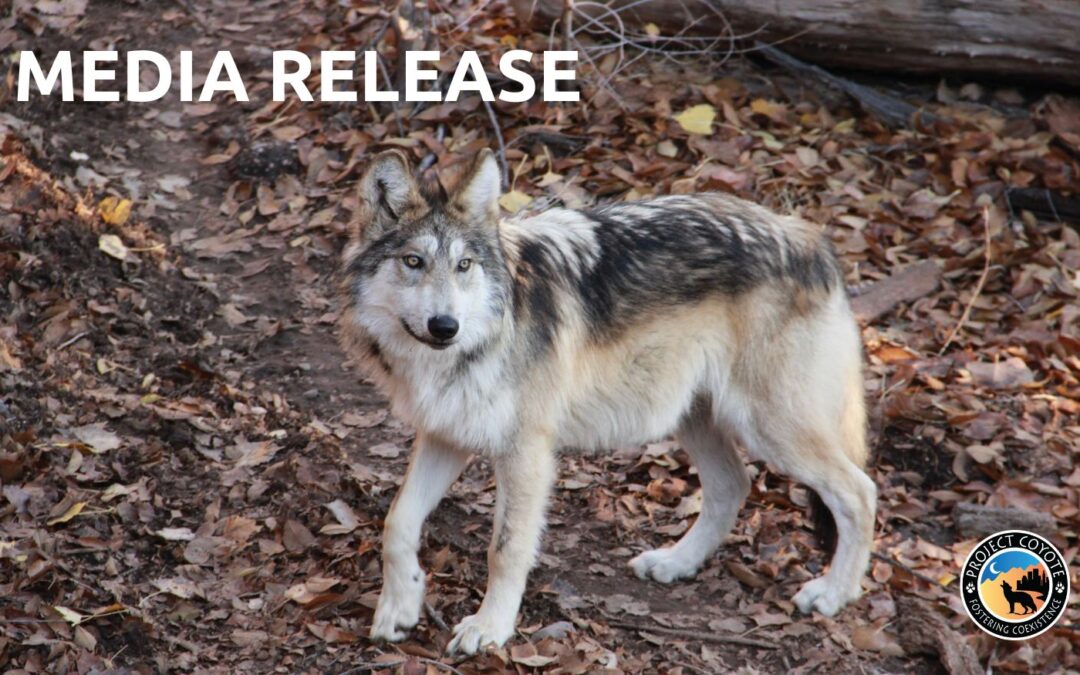FOR IMMEDIATE RELEASE — April 17, 2023
Contact: info@projectcoyote.org, Project Coyote, 415.945.3232
Government Agents Kill Endangered Mexican Gray Wolf Father, Threatening Pack’s Survival
SILVER CITY, N.M. – An endangered Mexican gray wolf has been killed in New Mexico by federal employees, according to a document released by the U.S. Fish and Wildlife Service. Affectionately named Rusty by a middle school student in a nationwide contest, the wolf was killed on April 12, leaving behind his likely pregnant mate and several yearling pups. The Service quietly authorized the killing on March 29, 2023 – the 25th anniversary of Mexican wolves’ return to the wild.
“This is a sad day for Mexican wolves and a devastating loss for the Mangas pack, which could be welcoming pups at any moment,” said Maggie Howell, Wolf Conservation Center executive director. “Apart from endangering the Mangas pack’s survival, science has shown that removing a wolf parent from the family can destabilize the pack and increase the likelihood of further conflicts.”
The Fish and Wildlife Service issued the order to kill Rusty because of his alleged involvement in multiple killings of cattle, most on public lands, and after an unspecified number of cattle carcasses from animals that had not been killed by wolves were found in the Mangas Pack’s territory. The Service has refused to follow the recommendations of scientists that livestock owners be required to remove the carrion from non-wolf-killed stock before wolves scavenge. In this instance it is not known whether the wolves fed on the carrion.
Conservationists warn that the removal of a breeding male could have severe consequences for the pack’s survival. It also might not reduce predations on domestic animals at all. Scientific studies show that wolf removal can exacerbate the potential for conflict, especially when breeding adults are killed. The remaining pack members, many of whom are learning to hunt, are more desperate to find food without the help of an experienced adult and thus are more likely to turn to unprotected livestock.
“Every single time a Mexican wolf is killed by the agency meant to protect and restore lobos, we need to remember: these are critically imperiled, native, ecosystem engineers who belong in the wilds of the American Southwest,” said Chris Smith, southwest wildlife advocate for WildEarth Guardians. “Cows are destructive, non-native animals that are only on the landscape to bring profits to a special interest.”
“The Service keeps this type of action under wraps until there’s already a dead wolf, limiting opportunities for meaningful discussions around conflict prevention or livestock management,” said Greta Anderson, deputy director of Western Watersheds Project. “The public has a right to know when there are kill orders for endangered wildlife. Both Mexican wolves and public lands belong to the American public and shouldn’t be managed exclusively for the livestock industry.”
“Livestock and lobos can coexist but it requires a consistent effort to use evidence-based preventative measures,” explained Michelle Lute, PhD in wolf conservation and carnivore conservation director for Project Coyote. “Where consistent efforts and proper husbandry practices like carcass clean up are not employed, as in this case, the interests of wild wolves and the broader public who want to see them thrive should trump private business interests on public lands.”
“We are heartbroken for the Mangas Pack who needlessly lost a family member at the hands of U.S. Fish and Wildlife Service,” said Renee Seacor, carnivore conservation advocate for The Rewilding Institute. “This pack of critically endangered Mexican wolves, with the loss of one of their elders, is now less likely to persist or reproduce in the wild and may feel the effects of this loss for generations.”
The Mangas pack lives in New Mexico near the state line with Arizona, in national forest allotments where livestock management has resulted in the previous removals of wolves including two pups from the pack shot by the government in March 2020. Federal employees have shot and killed 22 of the wolves since reintroduction began in 1998, and 24 others have died inadvertently as a result of capture. This latest killing highlights the ongoing prioritization of the private livestock industry over the recovery of the world’s most endangered gray wolf.
“The government should be targeting problem-prone grazing allotments instead of scapegoating wolves,” said Michael Robinson, a senior conservation advocate at the Center for Biological Diversity. “This wolf might still be alive if the Fish and Wildlife Service had only followed the science and required ranchers to remove the bodies of non-wolf-killed cattle before wolves began to scavenge. The available evidence here suggests wolves were drawn in by decaying cattle corpses.”
“The tragic loss of this wolf, especially during the denning season, puts the Mangas pack in a precarious position,” said Sally Paez, staff attorney for New Mexico Wild. “This successful father was contributing to his family and to the genetic health of these critically endangered animals.”
Background
The Mexican gray wolf is the southernmost subspecies of gray wolf in North America, and the most endangered. Exterminated from the United States and Mexico by the U.S. Fish and Wildlife Service and its predecessor agency, after the 1973 passage of the Endangered Species Act, seven wolves were successfully bred in captivity. Reintroduction into Arizona and New Mexico began in 1998. According to the most recent annual census, at least 241 Mexican gray wolves live in the wild in the United States. Several dozen also live in Mexico, where reintroduction began in 2011.

